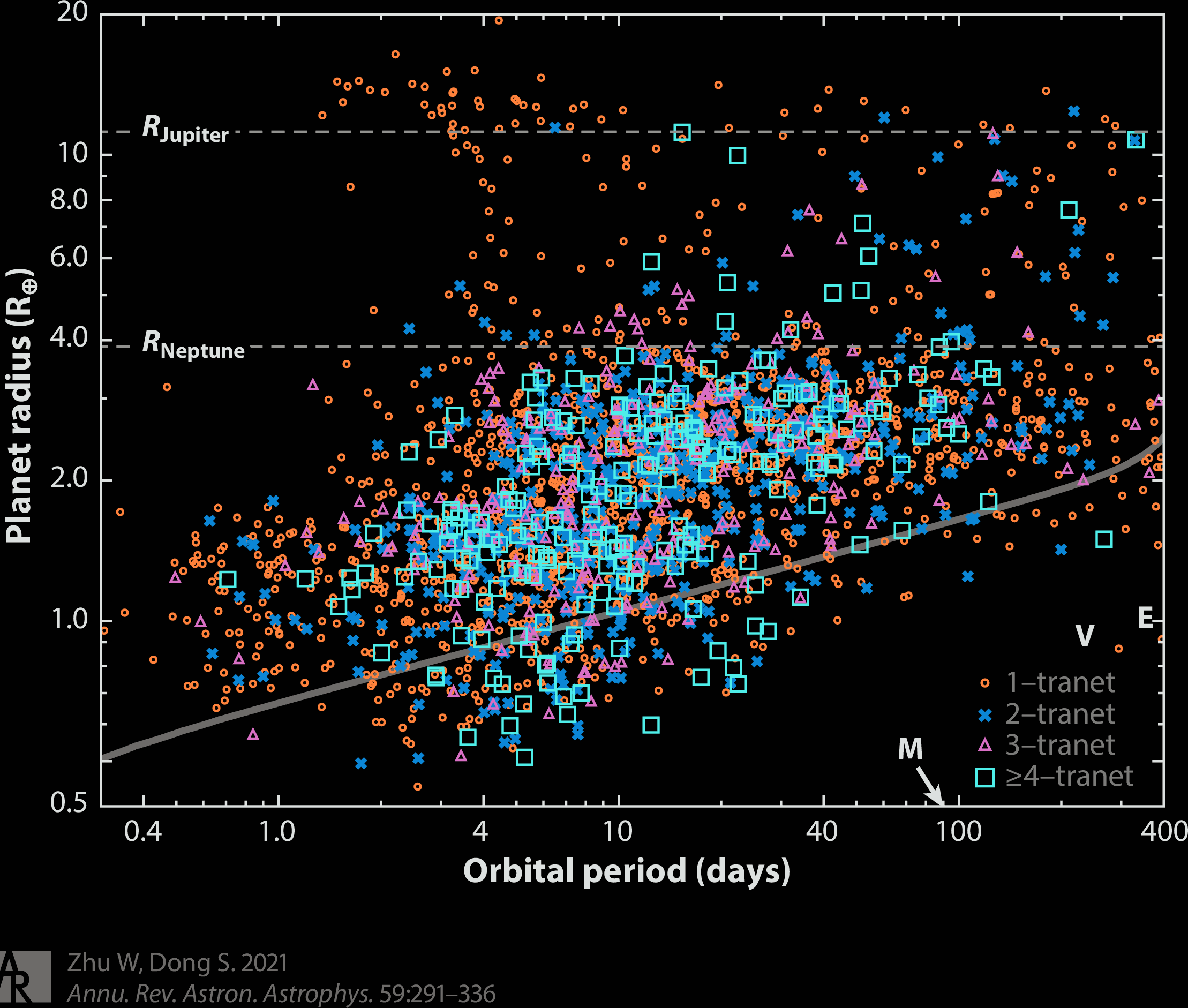Exoplanet Demographics#
Notes partially following Exoplanet Statistics and Theoretical Implications here. Supplemental slides available on D2L Astr545PlanStat.pdf under Content.
Friday, Apr. 4, 2025
astrophysics of stars and planets - spring 2025 - university of arizona, steward observatory
Today’s Agenda#
Announcements (2m)
Reading Overview/Key Points (10m)
ICA 21 - Exoplanet Populations (25m)
Debrief + Share Results (10m)
On Defining and Interpreting Planet Occurrence Rate#
Let’s start by tryinf to define the intrinsic occurrence rate (or the often interchangeably used term, frequency) of planets.
We can define a few different variables:
Occurrence rates#
We can define this occurance rate simply as (“the frequency of planets”):
Definition 127
this rate is the easiest to measure but requires the planets be resticted to a particular plane and assumptions about the host star and possible companions.
In this defintion we define the (“the frequency of planetary systems”)
Definition 128
Here, a planetary system is defined as a system with at least one planet existing in the pre-defined parameter space.
Lastly, the ratio of these quantities gives the (the average number of planets per planetary system):
Definition 129
In practice, we find that \(\bar{m_{p}}\) is very model / theoretically dependent, and \(F_{p}\) often requires many assumptions about the system.

The close-in (\(P\) < 400 days) Kepler planets in the period–radius plane, with various symbols and colors indicating the observed multiplicity (note that we use the contraction “tranet” to refer to “transiting planet” in the legend). The radius valley at \(\sim2 R_{\oplus}\) (see Section 2.1.4) is visible. Credit: Zhu & Dong 2021.
Planet Distribution in the Period–Radius Plane#
Hot Jupiters#
Recall our range for Hot Jupiters of planets with \(8 R_{\oplus} < R_{p} < 20 R_{\oplus}\) and \(P<10\) days.
Occurance Rates - Transit surveys statistics suggest \(\bar{n}_{p}\sim0.62\%\) where as RV studies typically report rates of about twice this value.
Solutions proposed: metallicity different between samples - likely too small of impact; However, because RV surveys preferentially exclude close (∼1–50 AU) stellar binaries from their samples, can potentially be resolved if the formation of hot Jupiters is suppressed in such close binary systems.
Multiplicity - Only 1 out of 49 in the above graphic show hot Jupiters with small close companions. Further analysis of the data suggest about \(2\%\) have nearby (\(\sim\)20 days), small (\(\sim1-4 R_{\oplus}\)), and nearly coplanar companions.
The low multiplicity rate of hot Jupiters supports the general idea that most of them have undergone some large-scale migrations to arrive at the current locations.
Hot Neptune desert#
Looking now at the region \(2 R_{\oplus} < R_{p} < 8 R_{\oplus}\) and \(P<2-4\) days is described as the Hot Neptune (or sub-Jovian) desert.
Occurance Rates - \(0.61 \pm 0.07\%\) for the total planet frequencies \(\bar{n}_{p}\).
Multiplicity - \(\sim 23\%\) of these systems have a companion, making the value higher than hot Jupiters.
Theories describing the triangle like boundaries include effects of photoevaporation and tidal effects. More massive stars can be circularized more efficiently without tidal effects.
Ultra-short-period planets#
Planets with radii of \(0.5-2.0R_{\oplus}\) and \(P<1\) day are known as Ultra-short-period planets (USPs). These are found to have \(\bar{n}_{p}=0.38\%\) planet frequencies with a multiplicity about \(20\%\) - but likely higher due to the misalignment of alot of these objects.
It has been suggested that these were not formed in-situ, partially due to the comparable rates to hot Jupiters. Multiple theories for this have been proposed.
Radius valley#
This region refers to a value of \(R_{p}\approx 2.0 R_{\oplus}\) and periods of \(3 < P < 30\) days.
The leading theory for this bifurcation is atmospheric evaporation driven by high-energy photons from the host star (photoevaporation).
Under this assumption: planets with core masses of a few Earth masses, the high-energy radiation is sufficient to unbind the entire hydrogen/helium atmosphere if its initial mass fraction is below some critical value.
Thus, the radius valley thus emerges, separating planets with and without extended atmospheres.
In-Class Assignment 21#
In-Class Assignment 21 can be found here.


